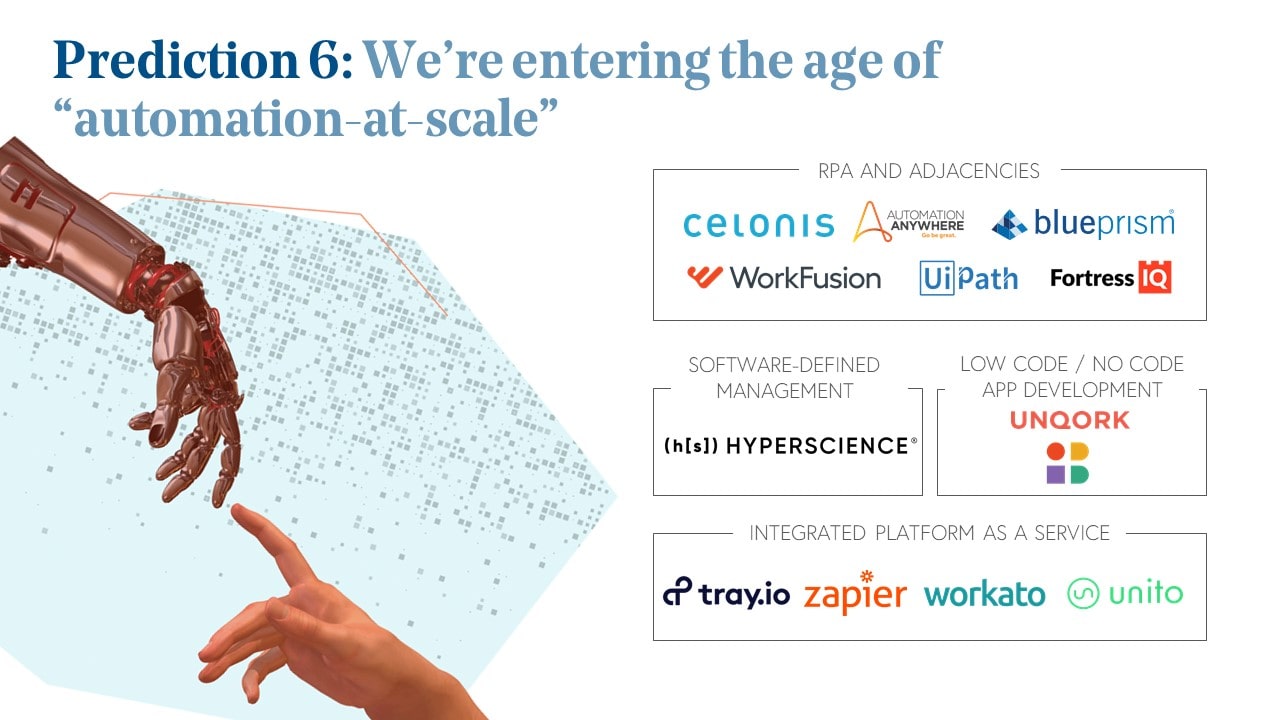Hyperscience is taking on the $60 billion enterprise automation industry
Bessemer leads Hyperscience’s $60 million Series C financing to bring the first Software-Defined, Input-to-Outcome Automation Platform to enterprise clients.
Data is the oil of the technology industry — the commodity that fuels enterprise software and hardware systems. Taking information from the physical world and turning it into digital data on which software applications and systems can run analyses is core to many $1 billion+ technology businesses. Historically, however, technology companies have been constrained by the human inputs required to make that data meaningful to a mindless piece of code. Inefficiencies result, with humans scaling with data, alongside costs and error rates.
As we discussed in the State of the Cloud 2020, “automation at scale” is a recent trend in software that aims to solve for this human constraint, using software to help operationalize data. The automation of workflows, business processes, and even application development allows companies to reduce error rates and increase productivity. There are multiple approaches to automation at scale: One of the most well-known is Robotic Process Automation, in which software “bots” are programmed to complete low intelligence tasks. Integrated-Platform-as-a-Service companies like Zapier and Unito also encourage workflow automation by enabling data flows between discrete applications through pre-built integrations. Both RPA and IPaaS are categories of automation that have been around for years, however, they have become more prevalent as of late as businesses come to appreciate the power of automation.

The next emerging and popular categories are “low” or “no code” application development platforms which empower mostly non-developers to build solutions without expert coding skills.
Finally, what we believe is the most promising category of automation at scale is Software-Defined Management (SDM), the principles of which simplify any desired business process into four simple steps:
- Identify the right data
- Ask the desired question through a defined metric
- Derive an answer from the most knowledgeable source (whether data or human)
- Proceed to the next step of a business process
With a business process broken down into its fundamental components and then packaged as an application, Software-Defined Management (SDM) can operationalize data more quickly and accurately than ever before. With SDM, business environments that utilize process automation can be dynamic and fluid, releasing customers from the static workflow requirements of RPA, and with human-machine collaboration still involved in some decision-making pathways, Software-Defined Management can take on the highest cognitive tasks.
Simply put, we see Software-Defined Management as the future of automation in the enterprise.
Our Series C Investment in Hyperscience
Bessemer Venture Partners is excited to announce that we led the Series C round in Hyperscience, the leader of the Software-Defined Management (SDM) category, and we are enthusiastic to partner with CEO and Co-Founder Peter Brodsky and his team.
Our first meeting with Peter was scheduled for 30 minutes, but we ended up talking for nearly two hours as we delved into his unique understanding of the enterprise automation problem that his customers were facing and the incredibly ambitious vision that he laid out for the future of the Hyperscience Platform. As investors with a thesis behind Automation-at-Scale, we aimed to invest in a business that drives value for its customers through automation not only by managing data input tasks but also by providing an ever-evolving ability to manage complex business processes. Hyperscience is that company.
Hyperscience came to market in 2017 with its Intelligent Document Processing (IDP) solution, and since then, has developed the building blocks for its Software-Defined, Input-to-Outcome Platform that will be released later this year. Hyperscience has built a next-generation business operating system that puts together data, people and processes into digital assembly lines, turning complex business processes into configurable workflows and solutions. It has done so by leveraging end-to-end ownership of the business process, from data input (what Hyperscience calls “Step 0”) to business outcome. The result is a solution that can stretch along a client’s enterprise workflow, help inform decisions and organize their human resources.
Today, dozens of customers spanning government, financial institutions, and insurance are using Hyperscience to harness the power of automation, reduce error rates, increase employee capacity and help end customers receive services faster – whether that’s shortening the time it takes to process claims, accelerating mortgage underwriting, or speeding up the back-office systems at TD Ameritrade.
It was through close attention to customers and a vision of automation that matched Bessemer’s own that led CEO Peter Brodsky and Hyperscience to define the Software-Defined Management category. As an expert in machine learning and serial entrepreneur, Peter has both the expertise to build end-to-end, enterprise-grade products and the customer empathy to understand automation needs across sectors.
“We founded Hyperscience with the goal of becoming the world’s leading automation company, and I am tremendously proud of the work this team has done over the past three years to deliver the first step of our mission,” said Peter Brodsky, Hyperscience’s CEO and co-founder. “As we take the next step, I am thrilled to be in the company of Elliott, Mary and Bessemer Venture Partners, as we accelerate innovation, further invest in our people, and bring the next version of Hyperscience to market.”
We believe Hyperscience is poised to define the next generation of enterprise automation at scale.
If you’d like to get in touch, please email Elliott at erobinson@bvp.com and Mary at mdonofrio@bvp.com.


